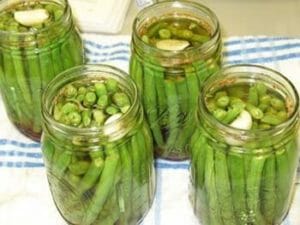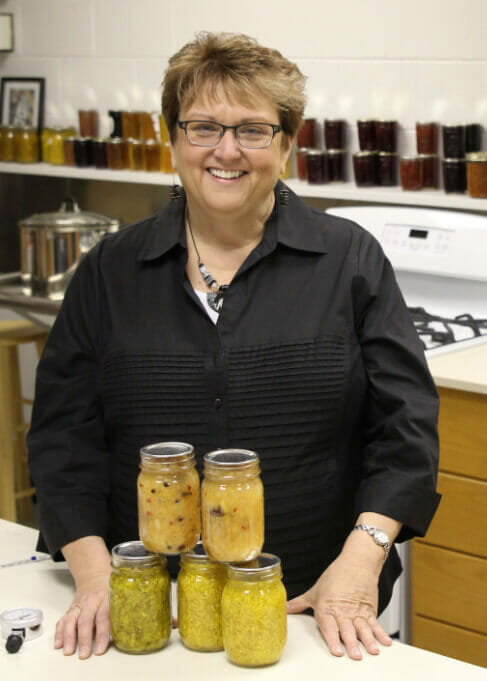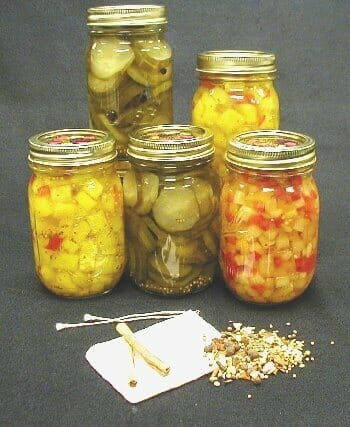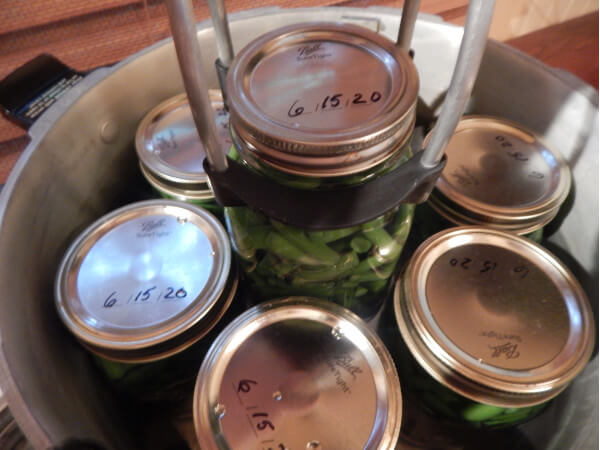This blog post covers the top five questions on home canning.

1. What are core concepts people should keep in mind when we talk about canning preservation?
2. I want to can my own favorite recipe. How do I determine a process so I can preserve my own favorite recipe?
3. Why do I have to process my pickles and jams in a canner? My mother didn’t.
4. Why do I have to use a pressure canner for my soup since I’ve already cooked it?
5. I forgot to vent my pressure canner before processing. Is my food safe?
And a bonus question!
6. How can we get people started with canning? Who should people trust for safety information to get it right?
Elizabeth L. Andress, Ph.D. is professor emerita, University of Georgia and former Director, National Center for Home Food Preservation.
PFSE Executive Director Shelley Feist spoke with Dr. Andress about the top safety questions related to home canning.
Feist: Elizabeth, thanks for joining us. Before we get into the top five safety questions I had a question. How much of home food preservation is art and how much is science?
Andress: Home food preservation is a science, with there being a little bit of allowance for “art” or creativity in a few methods, such as acid fruit-high sugar jams and dried fruit products. But for the most part, preserving food is a science to be followed to preserve them safely.
Feist: What are core concepts people should keep in mind when we talk about canning preservation?
Andress: Canning is definitely one of the methods of preserving food at home that falls mostly into the “science” of the practice being very important for safety. First, to keep methods standardized and safe, our research-based methods are going to use the terms “raw” or “hot pack.” RAW pack is putting uncooked, but properly prepared, pieces of food into your jar before covering them with hot or boiling liquid. HOT packs include heating the food by a prescribed method before putting it into your jar. The way foods are prepared and heated or not needs to be done the way they are described with the recommended process time.
Two other key terms you will see are “acid” or “low acid.” For the purposes of canning, acid is measured by the pH of the food and a specific cut off is related to the risk of botulism since we are keeping foods at room temperature in vacuum sealed jars. Clostridium botulinum bacteria like a low to no oxygen environment of low-acid foods at room temperature. If a food is over pH 4.6, then the bacteria that produce botulinum toxin will grow out and do so inside the jar if not killed during proper processing. So for canning, we call foods with a pH greater than 4.6 “LOW ACID” foods. Examples are meats, poultry, seafood, vegetables, soup mixes and some fruits. Foods with a pH 4.6 or lower are categorized as “ACID” foods for canning. Examples include many of our fruits, and properly acidified pickles and relishes. The risk of botulism is controlled in acid foods by the low pH, but there are still other pathogenic (harmful) and spoilage microorganisms that can be a problem in canned foods at room temperature if not killed by the amount of heat needed for each type of acid food.
PRESSURE canning is needed for low acid foods since killing the Clostridium botulinum bacteria putting us at risk for botulism are found naturally in foods in a very heat resistant form. (This is a spore form.) Pressure canning allows the environment surrounding the jars in the canning to get above boiling temperatures and accomplish killing of spores in reasonable amounts of time.
BOILING WATER canning is done with jars submerged completely in visibly boiling water over and around them during the whole process time and can be used with acid foods. Just because acid foods don’t put us at risk for botulism, though, there are other pathogenic or harmful bacteria, as well as spoilage organisms, of concern as mentioned above, that need to be killed during the process and before storing the foods.
Finally, canning processes call for a certain amount of HEADSPACE in jars. “Headspace” is the completely empty amount of space to be left above the food and under the lid of the jar. Headspace allows for expansion of foods during processing without allowing it or liquids to come out of the jar, is important in managing the amount of food going into jars for safety of the process, and allows a good vacuum seal to form upon cooling.

Feist: Here’s a common question, "I want to can my own favorite recipe. How do I determine a process so I can preserve my own favorite recipe?"
Andress: So many factors determine the best process to kill bacteria of concern in a sealed jar that will be stored at room temperature and the bottom line is you must have a safe canning process. Some things that play into that safe process include the actual ingredients, how those ingredients are prepared, how the mixture is heated or not before going into your jar and then into the canner, the ratios of liquid to solid ingredients, what the covering liquid is for pieces of food, jar size and shape, and what type of canner you are using.
So, as you can imagine there really aren’t available easy formulas to transfer from one research-based, tested recipe to another.
Mixtures of foods almost always have to have lab tests done to determine the heating pattern and rate in the canner for a specific recipe. And, I think we can all admit that the home environment is not a lab! So, this is very hard to do and not advised. We advise people not to try to do their own canning or preservation formula for a favorite recipe.

Feist: Here’s another common question, "Why do I have to process my pickles and jams in a canner? My mother didn’t."
Andress: There are some very acid pickles and some highly sugared mixtures that might be safe without processing the filled jars in a canner, but they still might spoil if not processed before storing.
Why waste all your ingredients (money) and time only to have the foods mold in the jars as they sit on the shelf? Even a short process can drive air out of the headspace before the lid seals and that can prevent oxidative or oxygen-induced browning of foods as they sit on the shelf. Also, mold spores float around in the air and can get in your jars as you fill the food into them. Molds will grow in acid and high-sugar foods and just need a small amount of oxygen that would be left inside the jar without processing.
This is why it is recommended for safety and quality that you use a canner.
Feist: Let’s talk about a low acid food now. Homemade soup can be so good. A common question is, "Why do I have to use a pressure canner for my soup since I've already cooked it?"
Andress: Remember with low acid foods, the canning process has to kill a very heat resistant form of Clostridium botulinum bacteria called spores. These spores are not killed by normal cooking temperatures. We don't get sick if we eat these spores in cooked foods. However, if the spores sit in a vacuum sealed (air-tight) jar at room temperature in low acid foods, they will grow out into their form (vegetative) that can multiple and produce botulinum toxin in the food. It is this toxin that makes us sick, and unfortunately can ever kill. You can't tell the toxin is in the food by sight or smell; you need to use a properly researched process for low acid foods to kill the spores before storing the food. If the toxin is formed in your food and you eat it, even a very tiny taste of this toxin can kill you. (A related comment is do NOT taste your home canned foods to see if you think they are safe if there is any reason to doubt it.)

Feist: Here's a related question. "I forgot to vent my pressure canner before processing. Is my food safe?"
Andress: Your food can indeed be unsafe from under-processing if you have not vented the air out of the pressure canner before bringing it to pressure to start processing. The temperature inside a pressure canner only reaches what is needed for a tested canning process when the air is vented out of the canner before processing begins. Air mixed in with steam inside the canner lowers the temperature associated with a given pressure. So our research-based processes need the air removed from the canner at the beginning to get to the expected processing temperature inside the canner. It's not just the pressure inside the canner that matters, it is the temperature that has to be associated with the recommended pressure.
Feist: How can we get people started with canning? Who should people trust for safety information to get it right?
Andress: USDA has been the historical source of publicly available, research-based information for home canning. And that means the USDA-affiliated Cooperative Extension System is a source in each state for safe, science-based recommendations also. Some traditional industry members also have sound research behind some of their recommendations, or even use the USDA recommendations, but unfortunately that is not true of all commercial enterprises these days. So the best place to start is your state Extension Service, most of which have local county or area offices, and websites. The USDA Complete Guide to Home Canning and the National Center for Home Food Preservation website are also great places to start to find the USDA and key state recommendations and resources. And a good reminder is that all of our recommended canning process times from these sources are meant to be used with the preparation procedures and jar sizes found with them, as well as with recommended canners and canner management steps provided.
Feist: Thank you, Dr. Andress! I think you’ve given readers of the Fight BAC! Blog some excellent information to get started with home canning. Thanks so much for sharing your incredible knowledge on home canning.
Check out the Partnership for Food Safety Education Facebook page to access a video interview with Dr. Elizabeth Andress.
Photos courtesy of Dr. Elizabeth Andress.